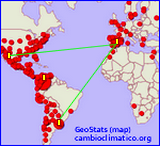(via Google translate) Delegates celebrate the adoption of the Protocol in 1997. It took a year to member countries of the Framework Convention on Climate Change decided that the Convention had to incorporate an agreement with more stringent requirements for reducing emissions of greenhouse gases.
The Convention entered into force in 1994, and in 1995 the government had started negotiations on a protocol, ie, an international agreement linked to the existing treaty, but with autonomy. The text of the Kyoto Protocol was adopted unanimously in 1997.
* The main feature of the Protocol is that it has mandatory targets on emissions of greenhouse gases for major world economies which have accepted. These targets range from -8% to +10% of the emission level of the different countries in 1999 "to reduce its total greenhouse gas emissions at a lower level in at least 5% below 1990 levels in the period engagement between 2008 and 2012. " In almost all cases, even where it has set a target of +10% from 1990 levels, limits require significant reductions in currently projected emissions. It provides for mandatory targets for the future "commitment periods" after 2012. These are negotiated well in advance of the periods concerned.
* The commitments under the Protocol vary from country to country. The overall objective of 5% for developed countries should be achieved by cutting (with respect to levels of 1990) of 8% in the European Union (EU [15]), Switzerland and most countries in Central and Eastern Europe , 6% in Canada, 7% in the U.S. (United States but later withdrew their support of the Protocol), and 6% in Hungary, Japan and Poland. New Zealand, Russia and Ukraine are to stabilize their emissions, while Norway may increase them to 1%, Australia 8% (later withdrew its support of the Protocol) and Iceland 10%. The EU has established its own internal agreement to meet its 8% target by distributing different rates among its member states. These objectives range from cuts of 28% in Luxembourg and 21% in Denmark and Germany to an increase of 25% in Greece and 27% in Portugal.
* To offset the harsh consequences of "binding targets", the agreement provides flexibility in how countries may meet their targets. For example, can partially compensate for their emissions by increasing "sinks", forests, which remove carbon dioxide from the atmosphere. This can be done well in the country or other countries. They can also pay foreign projects that result in a reduction in greenhouse gases. Several mechanisms have been established for this purpose (see paragraphs on "emission trading", the "Clean Development Mechanism" and "joint implementation".
* The Kyoto Protocol has been slow, is still in what is known as "phase of ratification" and is a complicated. Reasons abound. The protocol should not only be effective against a global problem is also complicated, must also be politically acceptable. As a result, has increased the number of groups and committees established to monitor and arbitrate different programs, and even after the approval of the agreement in 1997, it was considered necessary to engage in new negotiations to specify instructions on how to instrumentalize. These standards, adopted in 2001, are known by the name "Marrakesh Accords."
* International treaties must seek a delicate balance. Those who intend to achieve broad support are often not sufficiently strong to solve problems trying to solve (as it was felt that the UNFCCC had this deficiency, despite their many valuable provisions, the Protocol created in order to add). In contrast, those treated with strong provisions may have problems in getting the necessary support to be effective.
* What is really needed now is that the Protocol achieved sufficient ratifications to enter into force. Like the Protocol in general, this stuff is complicated. The Protocol will become legally binding when ratified by at least 55 countries, which have developed countries whose emissions account for at least 55% of total carbon dioxide emissions in 1990. This has not happened yet. The main problem is to decide adhere more industrialized nations will be affected by the Protocol's emission limits. A second concern is that the United States and Australia have already said they will not support the treaty.
* At the same time, a positive development is that some mechanisms of the Protocol have adequate support and are being established even before the entry into force of the Protocol. For example, the Clean Development Mechanism, whereby developed countries can meet part of their binding targets for emission by "credits" earned by sponsoring projects that reduce emissions of greenhouse gases in developing countries, have already with an executive board which is preparing proposals.
* To learn more about the details of the Kyoto Protocol, see the text of the Protocol.
Source: United Nations Environment Programme and laSecretaría on Climate Change (UNFCCC).


 IP registrada
IP registrada



















Comenta en Facebook